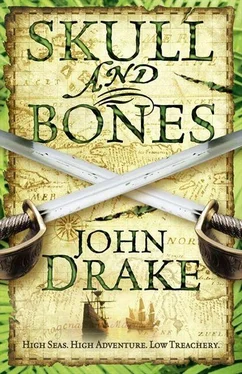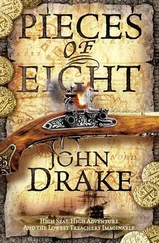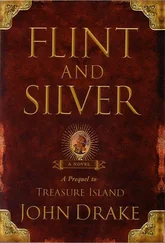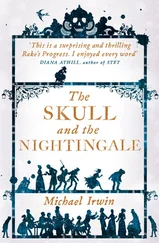John Drake - Skull and Bones
Здесь есть возможность читать онлайн «John Drake - Skull and Bones» — ознакомительный отрывок электронной книги совершенно бесплатно, а после прочтения отрывка купить полную версию. В некоторых случаях можно слушать аудио, скачать через торрент в формате fb2 и присутствует краткое содержание. Жанр: Прочие приключения, на английском языке. Описание произведения, (предисловие) а так же отзывы посетителей доступны на портале библиотеки ЛибКат.
- Название:Skull and Bones
- Автор:
- Жанр:
- Год:неизвестен
- ISBN:нет данных
- Рейтинг книги:5 / 5. Голосов: 1
-
Избранное:Добавить в избранное
- Отзывы:
-
Ваша оценка:
- 100
- 1
- 2
- 3
- 4
- 5
Skull and Bones: краткое содержание, описание и аннотация
Предлагаем к чтению аннотацию, описание, краткое содержание или предисловие (зависит от того, что написал сам автор книги «Skull and Bones»). Если вы не нашли необходимую информацию о книге — напишите в комментариях, мы постараемся отыскать её.
Skull and Bones — читать онлайн ознакомительный отрывок
Ниже представлен текст книги, разбитый по страницам. Система сохранения места последней прочитанной страницы, позволяет с удобством читать онлайн бесплатно книгу «Skull and Bones», без необходимости каждый раз заново искать на чём Вы остановились. Поставьте закладку, и сможете в любой момент перейти на страницу, на которой закончили чтение.
Интервал:
Закладка:
This is because, as I wrote the books, I increasingly felt an obligation to deliver up Long John Silver, in the end, as the character that Stevenson created – which was not my original intention.
When first I set out to write this series, I was fed up with characters in popular culture who were anti-heroes, half- heroes, and non-heroes: Batman, for instance, depicted as more sinister than the villains he conquers.
So, I decided to present John Silver as a cross between Dan Dare and Douglas Bader – and if you've never heard of them, please look them up (try Google), because they shaped my values as a child and still exemplify the virtues that I admire today.
Fair enough, then: Silver could start out like that. But I realised that he couldn't be the same truthful, decent, gentleman o' fortune by the end of Book Three. And so I contrived that he was forced into lies, betrayal and murder.
Not that there's no good left inside him! Not at all. But – to the best of my ability – as my trilogy ends, he is now the equivocal, crafty bugger that Stevenson made him. And dangerous besides.
Also, there's plenty more of him still in my imagination… such as the tale of what really happened to Jim Hawkins's expedition to Treasure Island…
LONDON UN-POLICED: CATCHING CRIMINALS
In Skull and Bones, much of the action in London depends on the fact that in the 1750s there was no police force in the modern sense, only a medieval mixture of constables, marshal's men, beadles and watchmen.
In fact, there were quite a lot of them: about 3,000 for a city of 750,000 people, which compares surprisingly well with modern figures. For instance, in June 2009, London's Metropolitan Police had c. 35,000 officers for a city of 7.5 million people. Thus, both then and now, there were about four officers per thousand of the population.
But modern officers are trained, and fit, and in constant communication by modern media, whereas the 1750s equivalents were commonly too old, too slow, and too corrupt to keep the king's peace – and each one was utterly on his own.
The Bow Street Runners, founded in 1749, were a unique exception, being remarkably efficient and honest (by eighteenth-century standards). They worked both as detectives and servers of writs, going up and down the kingdom – and even overseas – on missions such as I describe for my fictional
Philip Norton. They were the James Bonds of their time. But they were small in number (a few dozen officers), they had no uniform, and they did not patrol the streets to keep order: not them nor anybody else.
Another formidable obstacle to the apprehension of criminals was the fact that there was no way of showing a person's face to the public, other than by getting a talented artist to draw a likeness which would then be copied on to a copper plate – slowly, painfully, carefully – by equally talented engravers. Then prints could be made for wide distribution. This was a labour-intensive process, dependent on rare skills, and totally impractical for routine use, even if anybody had thought of using it to detect criminals, which they didn't! Thus recognition of criminals was strictly by eye, by people who already knew them.
Likewise there existed no means of mass communication, long-range communication, nor instant communication whereby the efforts of such officers as did exist could be united in the attempt to apprehend criminals.
Consequently, detection and apprehension of crime relied on direct, personal action, such as a householder catching a burglar, an employer detecting theft by an employee, or a traveller fighting back against a highwayman.
Thus, with Flint cut from the gallows, and the javelin-men beaten senseless, Silver and Flash Jack could spirit him away, because there was nobody whose duty it was to chase them. And once they were out of sight of those who could recognise them, then they were safe, because nobody knew who they were. Even Silver's crutch wouldn't necessarily give him away, for cripples were far more common then, than today.
LONDON UN-POLICED: THE MOB
As with crime, so with the London mob: that primordial force, deriving its name (as Dr Cowdray would have explained) from the Latin mobile vulgus meaning the moveable, or fickle, crowd for its dangerously volatile moods.
Once the mob was roused, there was nothing to stop it, as – famously – during the Gordon Riots of June 1780, when Lord George Gordon, a Protestant fanatic, roused the mob against the government's plan to liberalise the laws proscribing Catholics from public service or commissions in the armed forces. Anti-Catholic prejudice was deep-rooted in English society and the mob turned out in vast and unknown numbers, rioting for a whole week, and doing some Ј30,000 pounds worth of damage (Ј30,000,000 in today's money), burning churches, prisons and houses, savagely beating any Catholics it could find, and lighting bonfires throughout the city.
My account of the Georgian mob at play, in Chapters 26 and 27, is an accurate and restrained – I stress, restrained – description of historic reality. Even if there had been a police force, the mob would have rolled over it, so vast and ferocious as it was. Then, as today, faced with civil disturbance on this scale, the only answer would be to call out the army. In 1780, it took a week to get the necessary numbers of troops together and order was only restored with volleys of musketry fired into the mob, leaving hundreds killed and many more wounded.
Neither did I exaggerate in describing the use of paper-wrapped excrement as a missile, beloved of the mob. The eighteenth century even had a name for this little beauty: a flying pasty.
THE MUDLARKS
As a further example of the lawlessness of eighteenth-century London, I point out that almost everything I wrote about these river pirates is historically accurate: their strange name, their ferocious violence, their bribing the law to keep its nose out of their affairs, and their audacious thieving of anchor cables while a ship's crew slept. They were diamond geezers of eighteenth- century crime. I did, however, make up the title of 'King of the River' and there was no King Jimmy, as far as I know.
THE LEAP INTO HYPERSPACE: EIGHTEENTH-CENTURY STYLE
A common event in science fiction is the escape – say of Millennium Falcon – by leaping into hyperspace: that trans- dimensional realm where space is folded, time suspended and detection impossible. Well, an eighteenth-century sailing ship couldn't do that, but it did something very similar every time it went to sea, because once it had gone over the horizon, it was totally undetectable and totally unable to communicate with any person, place or ship that it couldn't see.
It is hard for us to appreciate the total isolation under which men sailed in those times, and their exclusive reliance on their own skills. For comparison, when Apollo 13 went wrong, the crew were the most isolated men-in-peril in all history. But they were in constant communication with base, where experts worked on a full-scale simulation of their vehicle to give advice.
And you didn't get that in the age of sail! You fixed it yourself or you died. You navigated skilfully or you died. You weathered the storm or you died. The sea made men out of boys, and heroes out of men… those it didn't kill.
There were a few and limited exceptions to the loneliness of sail. Warships routinely sailed in fleets, and in wartime merchantmen sailed in convoys. Also, ships – especially warships – could communicate by flag signals, but only when in sight of each other, only in daylight and only in good weather, and certainly not when you most needed it: when the fog closed in, off a lee shore, in foul weather, at night.
Читать дальшеИнтервал:
Закладка:
Похожие книги на «Skull and Bones»
Представляем Вашему вниманию похожие книги на «Skull and Bones» списком для выбора. Мы отобрали схожую по названию и смыслу литературу в надежде предоставить читателям больше вариантов отыскать новые, интересные, ещё непрочитанные произведения.
Обсуждение, отзывы о книге «Skull and Bones» и просто собственные мнения читателей. Оставьте ваши комментарии, напишите, что Вы думаете о произведении, его смысле или главных героях. Укажите что конкретно понравилось, а что нет, и почему Вы так считаете.












